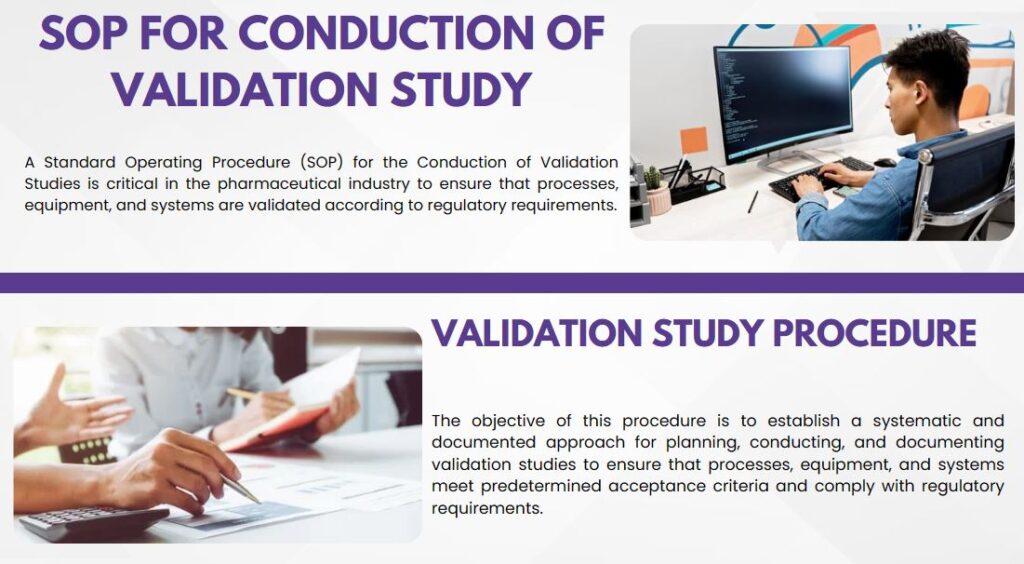
A Standard Operating Procedure SOP for Conduction of Validation Study is critical in the pharmaceutical industry to ensure that processes, equipment, and systems are validated according to regulatory requirements.
This procedure SOP for Conduction of Validation Study is to establish a systematic and documented approach for planning, conducting, and documenting validation studies to ensure that processes, equipment, and systems meet predetermined acceptance criteria and comply with regulatory requirements.
Objective:
To establish and maintain product integrity, performance and reliability, and to ensure that systems, procedures and equipments are clearly defined, functioning correctly, and are shown to be equipped to achieve the desired results.
SOP for Conduction of Validation Study Scope:
It is applicable to production and quality control and will cover the following subjects.
Process Validation Equipment Validation
- Prospective validation Installation Qualification
- Concurrent validation Operation Qualification
- Retrospective validation Performance Qualification
Responsibility:
Manager Quality Assurance/ Production Manager/ Engineering Manager
Validation Team
Validation team will be formulated to conduct all validation processes, team will include member from Production department, and engineering department and QA department itself will look after, compile and gather all data and observations concerning the project.
Procedure:
This procedure will cover following aspects of validation.
- Installation Qualification
- Operation Qualification
- Performance Qualification
PROTOCOL
A Protocol will be developed before each validation study. This protocol will be approved by Manager Quality Operations and authorized by Plant Manager. This protocol will be used as a written plan that states how this validation will be conducted. It will contain relevant information like product characteristics, production equipment to be used, test parameters, validated test methods to be used, and acceptance criteria. The data to be collected during the validation process must be specified in the protocol. The protocol should also define what sample must be taken, how they will be taken, and the frequency of sampling.
Analysis and Comparison to Acceptance Criteria
Once the data has been collected, it will be analyzed using statistical techniques and compared with the acceptance criteria.
Documentation SOP for Conduction of Validation Study
A brief conclusion will be written at the end of each validation study. Conclusion will discuss results of all parameters including physical and chemical against the acceptance criteria. Attached to the protocol should be all relevant documentation including a description of the equipment installation with drawings and specifications, test data from the validation runs and batch or production records.
Approval Process
The complete and filled protocol with conclusion of validation studies, along with all relevant documents will be reviewed and approved by the production, Assistant Q.A Manager and Manager Quality Operations.
Formal Review
After a period of three years, all processes and procedures will undergo revalidation process.
SOP for Conduction of Validation Study
Change Control
If the proposed change is within the parameters that have already been validated the revalidation will not be necessary. If the change is not consistent with the existing validation, the revalidation study of first three runs will be conducted before the implementation of change. Revalidation is done to maintain the validated state of the system.
Installation Qualification
This can be said as documented verification and that all key aspects of the installation adhere to manufacturer’s recommendations, appropriate codes and approval design intentions.
The Installation Qualification will be carried out during the installation of new equipment. The installation Qualification is a static check that establishes documentary evidence that process equipment and ancillary systems are constructed and installed to meet design intent.
Operational Qualification
This is also the documented verification that the system or sub system performs as intended throughout all its specified ranges.
All Equipments will be tested and evaluated to ensure it is capable of operating within the limits of the process and working of equipment in its worst condition. This process will include verification at upper and lower limits of the proposed use criteria.
Types of Validation
Prospective Validation
Prospective Validation is the established documented evidence that a designed system produces intended results, based on a planned protocol. Validation is designed for any new process, equipment or facility. It will be conducted prior to the distribution of either a new product or a product made under a revised manufacturing process.
Concurrent Validation
Concurrent Validation is the established documented evidence that a designed system produces intended results, based on information generated during actual implementation of the process. It may be synonymously referred as Performance qualification of a system.
This type of validation will be used when the product was already in distribution. It will be based on the Data derived from the current production runs. At least three runs of the product will undergo validation study.
Retrospective Validation
Retrospective Validation is the established documented evidence that a designed system produces intended results, based on review and analysis of historic information.
In this type of study, historical data of manufacturing records, in-process control testing, stability testing are reviewed and analyzed to reconfirm that control parameter ranges are appropriate.
This type of validation will be used when the product was already in distribution. It will be based on historical production, testing, and control Data. Minimum three runs will be analyzed.
Revision History: First issued.

